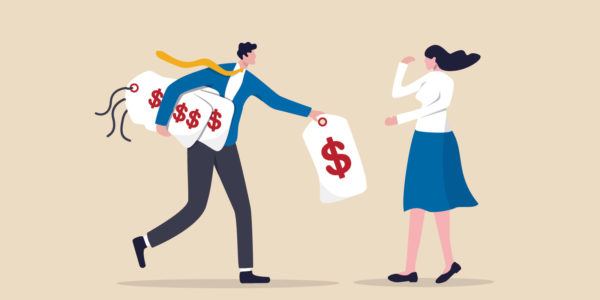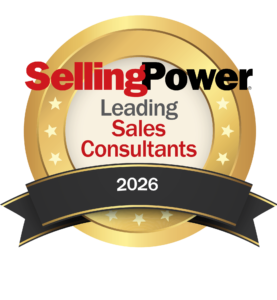Defending Your Price

Price objections are nothing to fear. In fact, salespeople should view them as a positive thing.
A price objection means two positive things:
- The customer is engaged enough to ask why your solution is more expensive than a less expensive option.
- You bring value to the organization you serve because, when a prospect objects to price, it’s a signal for the salesperson to begin guiding the customer to a decision.
In sales, your role is to help people see the value of your solution – not just educate, answer questions, or deliver the company marketing hype. Fortunately, there is a process that empowers you to do just that, and it starts with two initial steps.
Two Steps to See Your Solution’s Value
Step 1: Engage in Discovery – In a study of over 500,000 sales calls, the company Gong found that high performers were three times more successful when they addressed the price of their solution at around 40 minutes. This means high performers listen before they speak.
Other-centered selling means putting the customer first, getting in their head, walking around in their shoes, and figuring out what the world looks like from their office chair. You want to understand the individual and their business.
Relationship determines influence. This begins by demonstrating you genuinely care enough to get to know their situation and want to work with them to find a solution. So understanding what’s behind a price objection becomes part of a process.
Step 2: Understand What They Value – You can’t establish the value of your solution without first understanding what they value. So, dig deep:
- What do they really want, what do they need, and why?
- What’s the impact to getting what they want or not getting what they want?
Everybody wants something. Without answering these questions, it’s impossible to build value around a more expensive solution.
Before addressing a price objection, you need to know the value of your solution. Determine why a customer should pay more for your solution and, almost as important, why they shouldn’t.
Let me give you an example. A sales consultant running a training event needed to find a venue, and found two options. One was a boutique, small, cheaper venue and one was a large, considerably more expensive conference center designed for corporate events.
A novice at hosting training events, the buyer asked the rep at the conference center, “Why are you two times more expensive than the boutique?”
The rep stammered, hesitated, and just repeated what the conference center had to offer. The buyer didn’t see the value and, of course, booked the cheaper venue.
Big mistake. The Wi-Fi was insufficient, the amenities were non-existent, there was no IT support, the food was barely edible, and the air conditioning stopped working in the middle of the session. The buyer immediately understood why the conference center charged more. But the rep didn’t, and it ended up costing me more in the end.
If you don’t offer people an accurate picture of what you can offer, based on what they need, they’ll end up with a poor fit: bad coffee, bad acoustics, bad lighting, you get it. It is a service to take the time to understand what people need, then explain why they need to pay for it.
Handling Price Objections
Once you have this foundation in place, there are three key components to handling price objections.
Component 1 – Determine Why They Are Objecting to Price. If someone objects to price, don’t assume you know why. There are four common reasons: They were told to negotiate, they just like to negotiate, they need to make the internal sell first, or they don’t see the value.
- If someone is asking about price “because they’re supposed to,” flip the script: “Explain it to me. We have the solution for you that will get the results you need. Why would you want to pay less for that?” You will discover they do see the value. The objection was a poor attempt to drive down the cost. Therefore, hold firm.
- Don’t be intimidated by people with a win/lose mentality. Reinforce the value of what you offer but give a concession – something that costs you very little or nothing. This way, they feel like they won. Don’t be intimidated by someone who just likes to negotiate. As Covey said in his book 7 Habits of Highly Effective People, “win/win or no deal.”
- If they see the value but aren’t the ultimate decision maker, resist the urge to brush past them to work with someone with more buying authority. Focus on selling the evaluator first, build a relationship, and then work together to establish the value with the decision maker. Since they will be less capable of selling your solution without your support, be prepared to communicate why you need to work together.
- If they truly don’t understand the value, quantify the value gap and then, as Reason 2 above outlines, reinforce the solution with a concession. You now know your objective – but don’t rush to respond: You first need to create receptivity to your response.
Component 2 – Articulate and Validate Their Point of View: Do this once you’ve heard and understood their price objections. Don’t just cast it aside. Don’t rush to offer specific answers that presume an intimate knowledge of their situation. Demonstrate respect for their point of view and clarify what you’ve heard – ensuring you haven’t made any assumptions.
Step back and rearticulate and validate what they’re saying. Here are two examples:
- “What I’m hearing is that you’ve looked at our competitor and they seem to offer the same benefits but our solution/service costs $XX. So why would you pay $XX for the same solution?” Likely they will lean in, feeling understood, and say, “Exactly.”
- “First of all, it may not be obvious at first glance, so let me attempt to explain why it may make sense to pay more. Then you can decide if we should continue down this process.” By taking this non-combative response and validating their point of view creates receptivity. You are approaching the conversation as partners – helping them make the best decision. Then they are in the best position to hear the answer to their question: “Why should I pay more?”
Component 3 – Bridge the Value Gap: Build this bridge through message and delivery.
Determine how you can demonstrate that your solution delivers what they want. Focus on both a financial return (reduced cost or increased ROI) and the emotional benefit (e.g., quality of life, ease of operation, reduced risk). Be sure to craft a story that conveys this message based on similar customers. Stories elicit emotions and can be the easiest and most effective way to bridge the value gap.
Prepare your delivery. High performers pause after they deliver a price – indicating supreme confidence. No qualifiers. No hemming and hawing. Remember: People believe what you believe. Deliver the price with fewer words, pause, and people will believe you; in turn, they will pay more. State the price of your solution like you’re telling the time: It is what it is. You are confident, and they can be, too.
Become intimately familiar with the value your solution offers. Understand how it contrasts with the customer’s other options. Follow these steps and price objections lose their power. Customers will pay more, you will earn more commission, and you will quit wasting time on the price-only buyer.
If you would like to learn more about defending value, increasing customer receptivity and more, check out the book Unreceptive, written by Tom Stanfill.
Get our Enewsletter
Get the latest sales leadership insight, strategies, and best practices delivered weekly to your inbox.
Sign up NOW →